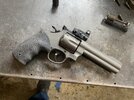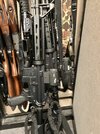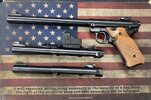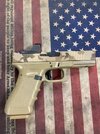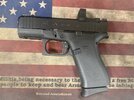For all y'all whose eyes have NOT aged like fine wine, maybe you started life NEARsighted with astigmatism, and later in life picked up FARsightedness...there are solutions to get a sharp front sight post without resorting to a RDS.
1. TRIFOCALS (of variousconfigurations)
Essentially, bifocals with another lens that splits the difference (Intermeidate). Intermediate will generally get you a sharp iron fornt sight post for pistols and rifles. If your cheek weld really puts your eye off at an angle (like, say, puting your nose on the charging handle of an AR-15), you may have to work that issue.
a1. Conventional Configuration (D Insert)
Conventional config looks like the usual bifocals with a "D" shaped lens insert laying on the round side along the bottom of the glasses. The intermediate lens is on top of that and is rectangular. Then the distance lense is everywhere else. Locations are like this:
DISTANCE
INTERMEDIATE D insert
READING D insert
a2. Conventional Configuration Franklin/Executive
Franklin/executive lenses are not D-shaped inserts, but go across the entirety of the glasses. The upside of these is that you do not have to move your head left/right to keep near/intermediate objects in focus. Can be handy.
DISTANCE all the way across
INTERMEDIATE all the way across
READING all the way across
These are the most general purpose of configurations for all life activities. If the conventional intermediate lens is too low, you may have to kep your head upright to see through it.
b. "Occupational" Configuration (D Insert Only)
If your eyes are like mine, maybe you have tried to paint the ceiling or work under cars and you have had to cock your head WAY back to get the close-ish object in focus with your glasses. That gets old, real fast. This is where "Occupational" trifocals come to the rescue. The intermediate D insert is up at the top of the glasses and the Reading D insert is low like conventional bifocals. Distance is through the middle. These allow, if you have trained for it, your old nice heads-down/arms parallel to the ground, slight crouch isosolese stance you may be used to after uncounted rounds downrange. The occupatoinal config is inferior to the conventional config if you use your glasses with a desktop computer with large screens at arms length. Also, I prefer conventoinal for driving, but occupational is still OK for driving. Occupational is best for shooting and working on autos, painting houses, flying planes, etc.
INTERMEDIATE D insert
DISTANCE
READING D insert
2. LASER (for low light)
There are training issues similar to RDS (target focus vs front sight focus). And they are not useful in bright light. But I have found Crimson trace laser grips last longer than most any tritium night sights I have owned (incl Trijicon). I prefer the laser grip for night sights and have them on all my J-frames.
1. TRIFOCALS (of variousconfigurations)
Essentially, bifocals with another lens that splits the difference (Intermeidate). Intermediate will generally get you a sharp iron fornt sight post for pistols and rifles. If your cheek weld really puts your eye off at an angle (like, say, puting your nose on the charging handle of an AR-15), you may have to work that issue.
a1. Conventional Configuration (D Insert)
Conventional config looks like the usual bifocals with a "D" shaped lens insert laying on the round side along the bottom of the glasses. The intermediate lens is on top of that and is rectangular. Then the distance lense is everywhere else. Locations are like this:
DISTANCE
INTERMEDIATE D insert
READING D insert
a2. Conventional Configuration Franklin/Executive
Franklin/executive lenses are not D-shaped inserts, but go across the entirety of the glasses. The upside of these is that you do not have to move your head left/right to keep near/intermediate objects in focus. Can be handy.
DISTANCE all the way across
INTERMEDIATE all the way across
READING all the way across
These are the most general purpose of configurations for all life activities. If the conventional intermediate lens is too low, you may have to kep your head upright to see through it.
b. "Occupational" Configuration (D Insert Only)
If your eyes are like mine, maybe you have tried to paint the ceiling or work under cars and you have had to cock your head WAY back to get the close-ish object in focus with your glasses. That gets old, real fast. This is where "Occupational" trifocals come to the rescue. The intermediate D insert is up at the top of the glasses and the Reading D insert is low like conventional bifocals. Distance is through the middle. These allow, if you have trained for it, your old nice heads-down/arms parallel to the ground, slight crouch isosolese stance you may be used to after uncounted rounds downrange. The occupatoinal config is inferior to the conventional config if you use your glasses with a desktop computer with large screens at arms length. Also, I prefer conventoinal for driving, but occupational is still OK for driving. Occupational is best for shooting and working on autos, painting houses, flying planes, etc.
INTERMEDIATE D insert
DISTANCE
READING D insert
2. LASER (for low light)
There are training issues similar to RDS (target focus vs front sight focus). And they are not useful in bright light. But I have found Crimson trace laser grips last longer than most any tritium night sights I have owned (incl Trijicon). I prefer the laser grip for night sights and have them on all my J-frames.


